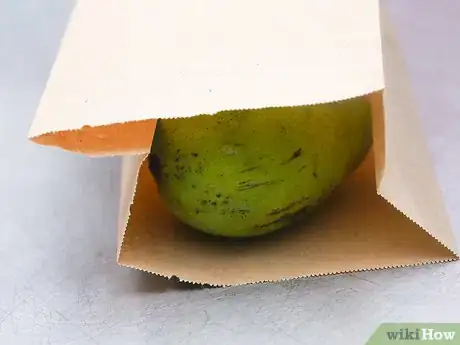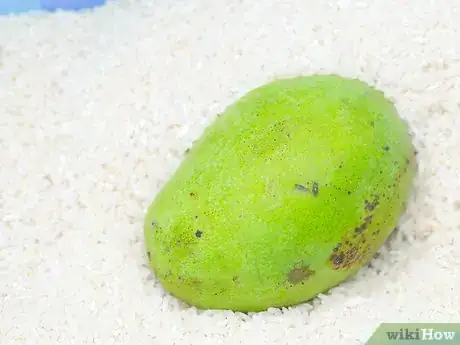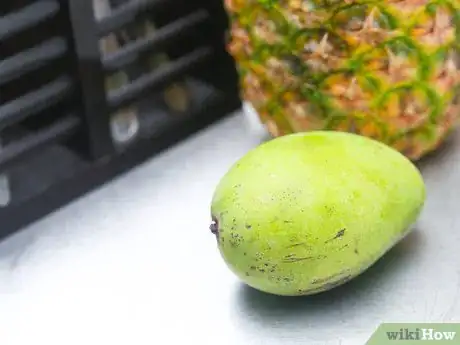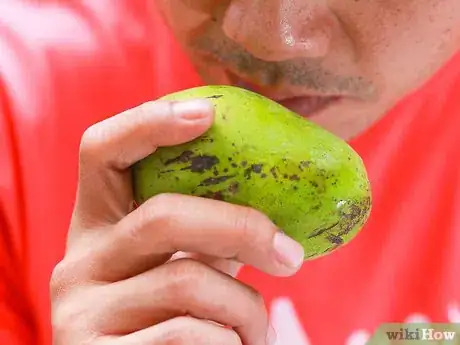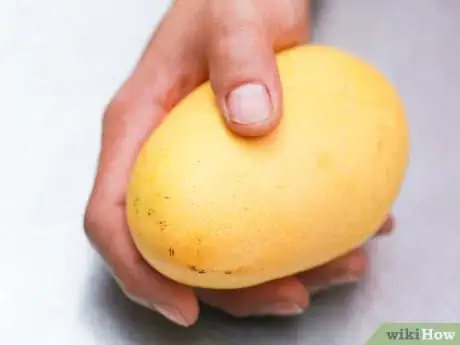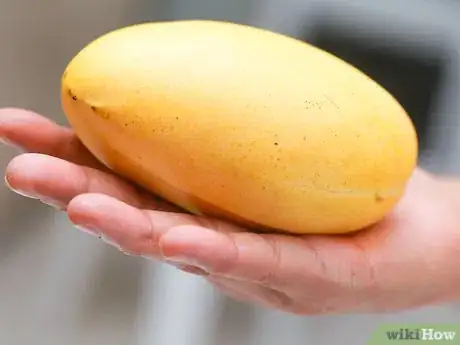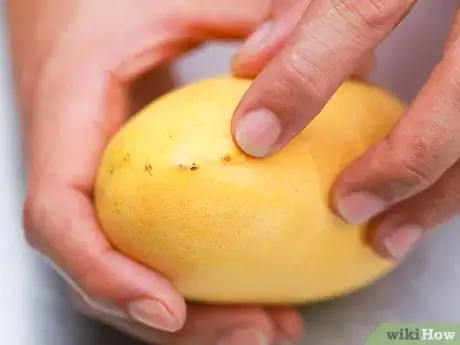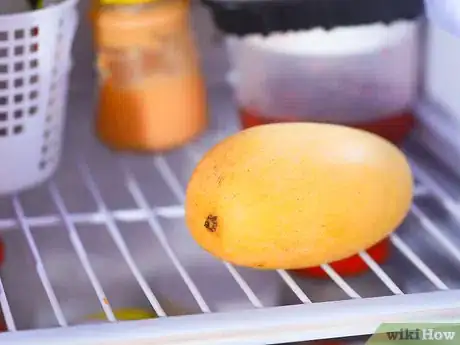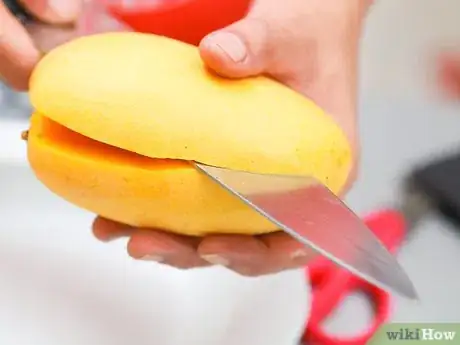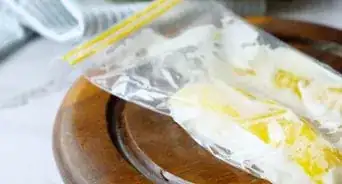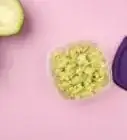This article was co-authored by Andrea Lawson Gray. Andrea Lawson Gray is a Private Chef and the Co-Founder of Private Chefs of the SF Bay. With more than ten years of experience, she specializes in Mexican cuisine and culinary history. Chef Andrea is also the author of Celebraciones Mexicanas: History, Traditions, and Recipes, an award-winning cookbook.
wikiHow marks an article as reader-approved once it receives enough positive feedback. This article received 30 testimonials and 100% of readers who voted found it helpful, earning it our reader-approved status.
This article has been viewed 824,039 times.
Originally grown in South Asia, mangoes are versatile fruit that are now raised in tropical zones, such as South America, Mexico and the Caribbean. You can eat mangoes on their own, or can include them in salsas, salads, smoothies or a variety of other dishes. Mangoes are rich in fiber, potassium, beta-carotene, and vitamins A and C. The enzymes in the fruit may act as digestive aids. Mangoes come in shades of green, red or yellow. Although some people eat unripe mangoes, which are tart in flavour, the fruit is sweeter when ripened. Use these tips to ripen mangoes.
Steps
Ripening the Mango
-
1Ripen the mango in a paper bag or newspaper. Leave the bag of mangoes on the kitchen counter overnight and check for ripeness in the morning. Mangoes wrapped in a paper bag will release ethylene, which is an odourless gas that speeds up the ripening process.[1] Remove and use the mango when it gives off a fruity scent and yields to soft pressure, usually about a day (or less).
- Alternatively, you could try ripening the mangoes by covering them with onions and hay in a warm place; this method of ripening was used for ages in India.
- When wrapping mangoes in a paper bag or newspaper, be sure not to close the bag completely. Some air and gas needs to escape or mold and mildew might start to form.[2]
- Add an apple or banana to the bag to speed up the ripening even more. Adding more ethylene-emitting fruits will increase the ethylene in the bag, giving you an even juicier mango all the quicker.
-
2Submerge the mango in a bowl of uncooked rice or popcorn kernels. This old wives trick hails from India, where industrious moms hid unripe mangoes in bags of uncooked rice to speed up the ripening.[3] In Mexico, the trick is much the same, except with uncooked popcorn kernels instead of rice. The ingredients are different, but the process and the results are the same: Instead of waiting three days for your mangoes to ripen au naturel, they should be ripe within a day or two, maybe even less.
- The reason behind the ripening here is the same as the paper bag method: Rice or popcorn helps trap ethylene gas around the mango, resulting in a much faster ripening process.
- In fact, this method is so effective that you sometimes risk overripening the mango. Check every 6 or 12 hours for doneness. As long as you don't forget the mango inside the bowl of rice, you should have a wonderfully ripe mango at your disposal.
Advertisement -
3Set the unripe mango on the kitchen counter at room temperature. You only need time and patience for this method. Mangoes, like other fruits, may take several days to ripen, but this is the most natural way of getting your mango plump, juicy, and ready to eat. Use the mango when it is soft to the touch and has a strong fruity smell.
Determining Ripeness
-
1Smell the mango for the most reliable results. Sniff the stem end of the mango. If it has a heavy, fruity, almost musky odour, it is ripe. It you're struggling to find an aroma, chances are your mango isn't quite there yet.[4]
-
2Squeeze the mango gently after you've sniffed. Check the firmness of the mango by pressing the mango gently. If it is soft and gives slightly, it is ripe.[5] A ripe mango feels similar to a ripe peach or ripe avocado. If the mango feels firm and unyielding, it is still unripe.
-
3Don't rely on colour to judge the ripeness of a mango. Although most ripe mangoes will also feature rich reds and burnt yellows more than soft greens, ripe mangoes are not always red and yellow. So forget the look of mangoes when determining ripeness. Instead, use smell and softness as your guide.
-
4Don't be scared away by a few black spots on the surface of the mango skin. Some people are scared away by mangoes that have a few splotchy, black blemishes on them. These blemishes usually indicate the beginning of the end for mangoes. While mangoes are notoriously susceptible to spoilage, black blotches don't necessarily mean the mango is bad. In fact, it may mean the mango has more sugar content.[6]
- If the black spots are especially soft, cut the mango open and look for translucent fruit. This is a sign of spoilage, and these mangoes should be thrown away.
- Use your senses if the mango in question has a few black spots: If it doesn't give too much, has a pleasant smell, and the skin is otherwise taut and richly-coloured, give the mango a go.
Storing the Mango
-
1Place the whole mango in the refrigerator when it has ripened. No wrap or container is necessary to store the mango in the refrigerator. You can clean it and place it in the rack. Keeping the mango in the refrigerator will slow down the speed at which the mango continues to ripen. Keep a whole ripe mango in the refrigerator for as long as five days.
- Never store a mango in the refrigerator before it has ripened. Like all tropical fruits, mangoes should not be stored in the fridge before they are ripe, as their fruit might be damaged by the cold temperature and the refrigeration will halt the ripening process.
-
2Peel and chop the ripe mango if desired. Place the chopped, ripe mango into an airtight container. Keep the container in the refrigerator for a few days. Keep chopped mango in an airtight container in the freezer for as long as 6 months.
Mango Varieties
| Variety | Appearance | Flavour |
|---|---|---|
| Haden |
One of the more popular types of mango, the Haden has smooth skin and the shape of kidney bean |
Full, sweet flavor |
| Van Dyke |
Popular throughout Europe, the Van Dyke is smaller and has a small nipple on the tip of the fruit |
Slightly spicy, not as rich as the prototypical mango |
| Kent |
Large and heavy, this mango cultivar can weigh as much as 1 and 1/4 pounds (.5 kg) |
Very tropical flavor |
| Ataulfo |
Slightly oblong, almost resembling a cashew |
Sweet, buttery, slightly acidic; the "champagne" of mangos |
| Tommy Atkins |
Bright, deep skin; shaped like a Haden |
Not as sweet as Haden, with medium fiber |
Community Q&A
Did you know you can get answers researched by wikiHow Staff?
Unlock staff-researched answers by supporting wikiHow
-
QuestionHow do you know when a mango is ready to be eaten?
 wikiHow Staff EditorThis answer was written by one of our trained team of researchers who validated it for accuracy and comprehensiveness.
wikiHow Staff EditorThis answer was written by one of our trained team of researchers who validated it for accuracy and comprehensiveness.
Staff Answer wikiHow Staff EditorStaff AnswerThere are several indicators that a mango is ready to be eaten. First, press the skin gently; it should give a little (if it gives too much, the mango is overripe and is best in a smoothie or used for deserts/baking). Second, the mango will smell sweet, fruity and delicious. Third, the color will no longer be green but will appear orange or red, or a combination in between (color on its own is not an indicator though - the other indicators must also be present). You’ll find more help here: How to Tell if a Mango is Ripe.
wikiHow Staff EditorStaff AnswerThere are several indicators that a mango is ready to be eaten. First, press the skin gently; it should give a little (if it gives too much, the mango is overripe and is best in a smoothie or used for deserts/baking). Second, the mango will smell sweet, fruity and delicious. Third, the color will no longer be green but will appear orange or red, or a combination in between (color on its own is not an indicator though - the other indicators must also be present). You’ll find more help here: How to Tell if a Mango is Ripe. -
QuestionWhat kind of chemical is used to ripen mangoes?
 wikiHow Staff EditorThis answer was written by one of our trained team of researchers who validated it for accuracy and comprehensiveness.
wikiHow Staff EditorThis answer was written by one of our trained team of researchers who validated it for accuracy and comprehensiveness.
Staff Answer wikiHow Staff EditorStaff AnswerEthylene gas is the natural gas used to ripen mangoes. Placing an unripe mango in a paper bag will cause the mango to release ethylene naturally, helping it to ripen. In some countries, calcium carbide has been used to ripen bananas but it is now considered carcinogenic and causes a wide range of health problems––this, it is not suitable for ripening fruit intended for human consumption.
wikiHow Staff EditorStaff AnswerEthylene gas is the natural gas used to ripen mangoes. Placing an unripe mango in a paper bag will cause the mango to release ethylene naturally, helping it to ripen. In some countries, calcium carbide has been used to ripen bananas but it is now considered carcinogenic and causes a wide range of health problems––this, it is not suitable for ripening fruit intended for human consumption. -
QuestionHow do you store cut ripe mango slices to prevent darkening?
 wikiHow Staff EditorThis answer was written by one of our trained team of researchers who validated it for accuracy and comprehensiveness.
wikiHow Staff EditorThis answer was written by one of our trained team of researchers who validated it for accuracy and comprehensiveness.
Staff Answer wikiHow Staff EditorStaff AnswerOnce sliced, mango deteriorates quickly, so act quickly to stop it from browning. One method is to squeeze a fresh lemon and sprinkle the juice over the slices; the ascorbic acid will slow down the browning. Or, you could use ascorbic acid derived from a vitamin C tablet; just crush a 250g tablet and add to 1 cup ice water, then brush the mango slices with this. Freezing the slices will also stop them from browning.
wikiHow Staff EditorStaff AnswerOnce sliced, mango deteriorates quickly, so act quickly to stop it from browning. One method is to squeeze a fresh lemon and sprinkle the juice over the slices; the ascorbic acid will slow down the browning. Or, you could use ascorbic acid derived from a vitamin C tablet; just crush a 250g tablet and add to 1 cup ice water, then brush the mango slices with this. Freezing the slices will also stop them from browning.
Warnings
- Do not store unripe mangoes in the refrigerator. Unripe mangoes will not ripen in the refrigerator's cold environment.⧼thumbs_response⧽
Things You'll Need
- Mango
- Paper bag
- Apple
- Airtight container
- Refrigerator
References
- ↑ http://www.scientificamerican.com/article/origin-of-fruit-ripening/
- ↑ http://lifehacker.com/267512/ripen-green-tomatoes-with-newspaper/
- ↑ https://spoonuniversity.com/how-to/how-to-ripen-a-mango-faster-so-you-don-t-have-to-wait
- ↑ https://insanelygoodrecipes.com/how-to-ripen-a-mango/
- ↑ https://insanelygoodrecipes.com/how-to-ripen-a-mango/
- ↑ http://www.tonytantillo.com/producetips/fruits/mangoes.html
About This Article
To ripen mangoes, wrap them in a brown paper bag and leave them overnight, which will speed up the ripening process. You can also add an apple or banana to the bag to make the mangoes ripen even faster. If you don't have a paper bag, try submerging the mangoes in a bowl of uncooked rice or popcorn kernels overnight, which will also help them ripen sooner. If you're not in a rush, leave the mangoes out on a counter at room temperature and wait a few days for them to ripen. If you want to learn how to store fresh mango, keep reading the article!
